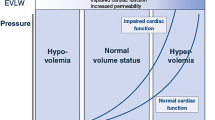Abstract
An increasing number of NIRS devices are used to provide measurements of peripheral tissue oxygen saturation (StO2). The aim of the present study is to test the hypothesis that despite technological differences between devices, similar trend values will be obtained during a vascular occlusion test. The devices compared are NIRO-200NX, which measures StO2 and oxyhemoglobin by spatially resolved spectroscopy and the Beer–Lambert law, respectively, and INVOS 5100C and Foresight Elite, which both measure StO2 with the Beer–Lambert law, enhanced with the spatial resolution technique. Forty consenting adults scheduled for CABG surgery were recruited. The respective sensors of the three NIRS devices were applied over the brachioradial muscle. Before induction of anesthesia, 3 min of ischemia were induced by inflating a blood pressure cuff at the upper arm, whereafter cuff pressure was rapidly released. Tissue oxygenation measurements included baseline, minimum and maximum values, desaturation and resaturation slopes, and rise time. Comparisons between devices were performed with the Kruskal–Wallis test with post hoc Mann–Whitney pairwise comparisons. Agreement was evaluated using Bland–Altman plots. Oxyhemoglobin measured with NIRO responded faster than the other NIRS technologies to changes in peripheral tissue oxygenation (20 vs. 27–40 s, p ≤ 0.01). When comparing INVOS with Foresight, oxygenation changes were prompter (upslope 311 [92–523]%/min vs. 114[65–199]%/min, p ≤ 0.01) and more pronounced (minimum value 36 [21–48] vs. 45 [40–51]%, p ≤ 0.01) with INVOS. Significant differences in tissue oxygen saturation measurements were observed, both within the same device as between different devices using the same measurement technology.






Similar content being viewed by others
References
Scheeren TW. Journal of Clinical Monitoring and Computing 2015 end of year summary: tissue oxygenation and microcirculation. J Clin Monit Comput. 2016;30:141–6.
Moerman A, Wouters P. Near-infrared spectroscopy (NIRS) monitoring in contemporary anesthesia and critical care. Acta Anaesth Belg. 2010;61:185–94.
Hyttel-Sorensen S, Hessel TW, Greisen G. Peripheral tissue oximetry: comparing three commercial near-infrared spectroscopy oximeters on the forearm. J Clin Monit Comput. 2014;28:149–55.
Hyttel-Sorensen S, Sorensen LC, Riera J, Greisen G. Tissue oximetry: a comparison of mean values of regional tissue saturation, reproducibility and dynamic range of four NIRS-instruments on the human forearm. Biomed Opt Express. 2011;2:3047–57.
Bezemer R, Lima A, Myers D, Klijn E, Heger M, Goedhart PT, Bakker J, Ince C. Assessment of tissue oxygen saturation during a vascular occlusion test using near-infrared spectroscopy: the role of probe spacing and measurement site studied in healthy volunteers. Crit Care. 2009;13(Suppl 5):S4.
Messere A, Roatta S. Influence of cutaneous and muscular circulation on spatially resolved versus standard Beer–Lambert near-infrared spectroscopy. Physiol Rep. 2013;1(e00179):1–10.
Canova D, Roatta S, Bosone D, Micieli G. Inconsistent detection of changes in cerebral blood volume by near infrared spectroscopy in standard clinical tests. J Appl Physiol. 2011;110:1646–55.
Mansouri C, L’Huillier JP, Kashou NH, Humeau A. Depth sensitivity analysis of functional near-infrared spectroscopy measurement using three-dimensional Monte Carlo modelling-based magnetic resonance imaging. Lasers Med Sci. 2010;25:431–8.
Metz AJ, Biallas M, Jenny C, Muehlemann T, Wolf M. The effect of basic assumptions on the tissue oxygen saturation value of near infrared spectroscopy. Adv Exp Med Biol. 2013;765:169–75.
Moerman A, Vandenplas G, Bové T, Wouters P, De Hert S. Relation between mixed venous oxygen saturation and cerebral oxygen saturation measured by absolute and relative near-infrared spectroscopy during off-pump coronary artery bypass grafting. Br J Anaesth. 2013;110:258–65.
Lee JH, Park YH, Kim HS, Kim JT. Comparison of two devices using near-infrared spectroscopy for the measurement of tissue oxygenation during a vascular occlusion test in healthy volunteers (INVOS® vs. InSpectra™). J Clin Monit Comput. 2015;29:271–8.
Fellahi JL, Butin G, Fischer MO, Zamparini G, Gérard JL, Hanouz JL. Dynamic evaluation of near-infrared peripheral oximetry in healthy volunteers: a comparison between INVOS and EQUANOX. J Crit Care. 2013;28:881.e1–6.
Meredith IT, Currie KE, Anderson TJ, Roddy MA, Ganz P, Creager MA. Postischemic vasodilation in human forearm is dependent on endothelium-derived nitric oxide. Am J Physiol. 1996;270:H1435–40.
Tripodaki ES, Tasoulis A, Koliopoulou A, Vasileiadis I, Vastardis L, Giannis G, Argiriou M, Charitos C, Nanas S. Microcirculation and macrocirculation in cardiac surgical patients. Crit Care Res Pract. 2012;2012:654381.
Pocivalnik M, Pichler G, Zotter H, Tax N, Müller W, Urlesberger B. Regional tissue oxygen saturation: comparability and reproducibility of different devices. J Biomed Opt. 2011;16(5):1–5.
Scheeren TWL, Schrober P, Schwarte LA. Monitoring tissue oxygenation by near infrared spectroscopy (NIRS): background and current applications. J Clin Monit Comput. 2012;26:279–87.
Acknowledgements
This work was supported by the Department of Anesthesiology, Ghent University Hospital, Ghent, Belgium.
Author information
Authors and Affiliations
Corresponding author
Ethics declarations
Conflict of interest
A.M. has received lecture fees from Medtronic (INVOS) and Sorin (NIRO). None of the other authors have a conflict of interest.
Rights and permissions
About this article
Cite this article
Steenhaut, K., Lapage, K., Bové, T. et al. Evaluation of different near-infrared spectroscopy technologies for assessment of tissue oxygen saturation during a vascular occlusion test. J Clin Monit Comput 31, 1151–1158 (2017). https://doi.org/10.1007/s10877-016-9962-1
Received:
Accepted:
Published:
Issue Date:
DOI: https://doi.org/10.1007/s10877-016-9962-1




